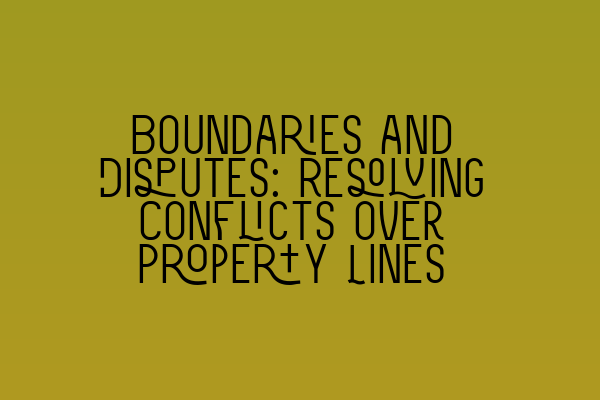Boundaries and Disputes: Resolving Conflicts over Property Lines
When it comes to real estate, conflicts over property lines can be a common source of disputes between neighbors. Understanding your property boundaries and knowing how to resolve conflicts in a legal and amicable manner is crucial in maintaining good relationships with your neighbors and protecting your property rights.
Defining Property Boundaries
Property boundaries are the lines that demarcate one property from another. These lines are typically determined by a combination of legal descriptions, surveys, and physical markers such as fences or walls. It is important to note that property boundaries are not always straightforward, especially in cases where the legal descriptions are unclear, or there are conflicting surveys.
In order to determine your property boundaries, it is recommended to consult the title deed of the property, which typically includes a legal description of the land. Additionally, you can hire a professional surveyor to conduct a boundary survey, which will accurately determine the exact location of your property lines.
Common Boundary Disputes
Boundary disputes can arise due to various reasons, including:
- Encroachment: This occurs when a neighbor’s structure, such as a fence or building, extends beyond their property line onto your land.
- Discrepancy in legal descriptions: If the legal descriptions of adjoining properties are inconsistent or ambiguous, it can lead to disputes over the boundary lines.
- Fence placement: Disagreements can arise when the location of a fence does not align with the true property boundary.
- Prescription and adverse possession: These legal doctrines can come into play when a neighbor has openly and continuously used a portion of your land for a certain period of time, potentially resulting in a claim of ownership.
Resolving Boundary Disputes
When faced with a boundary dispute, there are several steps you can take to resolve the issue:
- Communication: Begin by having a calm and open conversation with your neighbor to discuss the issue. Often, misunderstandings or simple mistakes can be resolved through communication.
- Review the legal documents: Consult the title deed of your property and any relevant surveys to determine the accurate boundary lines. It is helpful to gather all the necessary evidence to support your case.
- Mediation: If direct communication does not yield a resolution, consider engaging in mediation. A neutral third party can help facilitate discussions and find mutually agreeable solutions.
- Legal action: If all else fails, you may need to take legal action to protect your property rights. Consult with a property law solicitor who specializes in boundary disputes to understand your legal options.
It is important to approach boundary disputes with a level-headed mindset and a willingness to compromise. Remember, maintaining a good relationship with your neighbor is often in your best interest as they may play a role in the resolution of the dispute.
For more in-depth information on property law and related topics, you may find the following articles helpful:
- SQE Contract Law: Analyzing Landmark Cases and Influential Judicial Decisions
- Understanding Contractual Capacity: Rights and Limitations
- Interactive SQE Mock Tests for Contract Law: Test Your Knowledge
- Join Our SQE Contract Law Webinars: Expert Insights and Guidance
- SQE Prep: Mastering the Essentials of Contract Law
In conclusion, resolving conflicts over property lines requires a combination of clear communication, accurate understanding of legal documents, and, if necessary, seeking professional legal guidance. By approaching boundary disputes with a willingness to find common ground, you can protect your property rights and maintain good relationships with your neighbors.
